Castle Rock
WKR
- Joined
- Mar 28, 2020
- Messages
- 1,729
I would still be confident to go up against most opponents one on one with my S&W model 15 with decent ammo.
Follow along with the video below to see how to install our site as a web app on your home screen.
Note: This feature may not be available in some browsers.
Yes the goal posts have movedGiven the wide availability of body armor, I can see the logic behind aiming higher if I'm trying to stop a threat.
If I interpreted this correctly then the data says that shooters should target the head/neck in combat pistol shooting, only taking a high center chest shot when either capabilities or shot presentation don't allow for the former?
Obviously high cns hits stop threats the fastest I just don't know enough about combat pistol shooting to have a say in the smaller target being hit consistently enough under pressure to offset the size compared to the aforementioned high center chest shot.
Thanks for an actual data summary. This is what I was askingQuite a few years back (I think the study was published in the 2015-2017 timeframe), the US military did a study on servicemember combat lethality in relation to weapons used vs shot placement vs shot distance vs time. Sadly, I don't actually have that study in front of me and it has been a few years since I read it, so the percentages below might be off slightly but they are close and I will try to find a digital copy and upload it so others can read through it as well or at least post the actual name of the study so they can look it up.
To roughly sum the study up, it found that at CQB ranges (roughly 5-15 yards if I remember correctly) when using rifles hits to COM resulted in a roughly 80% one shot stop rate (meaning the aggressor immediately stopped aggressive action) with each successive round increasing that rate proportionally (ie one round had an 80% chance of stopping the fight and two had a 96% chance and so on). In that same scenario, a head shot had a roughly 95% chance with each successive round increasing the rate proportionally. Using handguns, those numbers dropped to roughly 70% for COM and 90% for headshots. The researchers arrived at those numbers based off of studying after action reports from military and police shootings, so not the absolute best scientific technique but it's not like they could just go out and shoot random people.
The more interesting thing that the researchers found was that among average trained servicemembers with an infantry MOS, the difference in time to make a single head shot vs two COM shots was that the single head shot slightly faster on average than the two COM using a rifle at CQB distances with any additional follow up shots being roughly the same. Using handguns, the time difference for one head vs two COM was a slight increase with roughly equal follow ups. Among highly trained servicemembers (think Delta, SEALS, Rangers, etc.), the single headshot was faster with both rifles and handguns again with roughly equal follow up shots. This portion of the test was done in shoot houses designed for CQB training and other static ranges with targets being considered neutralized once a single headshot or two COM hits were recorded.
It also found that the average trained servicemembers had a higher chance of missing the headshot on their first round using a rifle vs missing with at least one of the COM shots requiring a follow up, and they were more likely than not to miss the headshot using a handgun, but with the higher trained service members the chances of a miss was roughly the same. For non infantry or special operations MOS servicemembers the two rounds COM was much faster and more accurate than the headshot using both rifles and handguns.
At longer ranges the lethality percentages and the times required for accurate hits changed for both handguns and rifles, which isn't really germane in this context but suffice it to say rifles are much more lethal and faster than handguns as the distance increases.
This study actually demonstrates why the standard training for both military and law enforcement focuses on aiming COM and firing until the threat is stopped vs aiming for a headshot. However, in more advanced training (like what Delta, Devgru, and other special operations/SWAT units go through) headshots are more likely to start becoming the preferred target at CQB ranges.
So basically, when starting out with a handgun practice for accurate COM hits as fast as you can make them and then when you become much more proficient (I would recommend waiting until you can perform sub 2.5 second Bill Drills "cold" on demand), then you can start practicing for headshots at the same speed.
Obviously?You can blow out a dude's heart, and have him literally be a dead man walking - and he still has about 15 seconds of oxygen in his muscle and brain to keep trying to kill you. The only thing that truly ends a fight instantly and safely for everyone around is a CNS hit.
This study actually demonstrates why the standard training for both military and law enforcement focuses on aiming COM and firing until the threat is stopped vs aiming for a headshot. However, in more advanced training (like what Delta, Devgru, and other special operations/SWAT units go through) headshots are more likely to start becoming the preferred target at CQB ranges.
So basically, when starting out with a handgun practice for accurate COM hits as fast as you can make them and then when you become much more proficient (I would recommend waiting until you can perform sub 2.5 second Bill Drills "cold" on demand), then you can start practicing for headshots at the same speed.
If you are referencing the CBA, it’s not publicly released, and those were not the conclusions.
Further, anything that is relying on someone’s memory, or perception is notoriously unreliable and more often than not inaccurate. There is no need for someone’s belief of opinion, or story. There are hundreds and hundreds of videos of shootings that anyone can watch and see what happens when people are shot.
What is the percentage of people- including “Delta, Devgru, and other special operations/SWAT units” that you believe are doing sub 2.5 sec clean bill drills cold on demand?
On demand with a handgun, people (or at least shooters) in general, probably well less than 1%. People in those sort of specialized units, I would guess around 40-50%,
Probably around the same when you look at competitive shooters who actually train and compete regularly (ie someone who is a low level A or high B class USPSA or high level SS or low expert class IDPA shooter).
That was basically my way of saying don't train to make headshots for personal defense with a handgun unless you are one of the top .5% of shooters; and, even then be honest with yourself and understand that being able to make that sort of shot on a static range, or even in competition, is not the same as doing it in a life or death scenario.
I now feel immensely better about my Bill Drill times.
15 feetishyards?Beyond that, the skill to hit a 6” target at 0-15’ish yard
In pictures the older single stack C’s frame looks just as wide as a double stack model. Is that true? If so, what makes the single stack version preferable for carry?Very good pistols. If they still made them, they would be the answer for a production CCW pistol.
In pictures the older single stack C’s frame looks just as wide as a double stack model. Is that true? If so, what makes the single stack version preferable for carry?
In pictures the older single stack C’s frame looks just as wide as a double stack model. Is that true? If so, what makes the single stack version preferable for carry?
In pictures the older single stack C’s frame looks just as wide as a double stack model. Is that true? If so, what makes the single stack version preferable for carry?
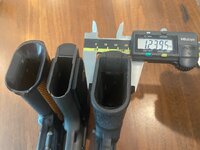

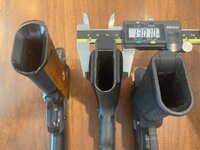
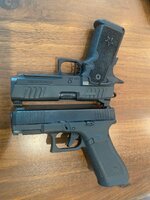
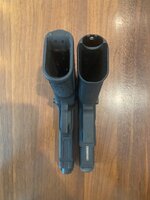
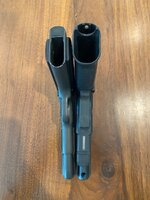
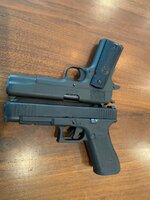
I don't have an old C but the new C is actually narrower than a 1911.
They beat the system with the polymer grip module.
View attachment 914896View attachment 914894View attachment 914895
The new C is pretty much the same size as a G45.
View attachment 914897View attachment 914893
I wonder 2 things:
- why they called the new gun a "c" too...seems dumb...the old single stack "c" isn't "old".
- why they released a 3.5" barrel gun (CS) and 4" barrel gun (C) before a full sized 5" gun. I bet that's what they will release next.
A real 1911 is more similar to a G34:
View attachment 914899
View attachment 914900
I don't have an old C but the new C is actually narrower than a 1911.
They beat the system with the polymer grip module.
View attachment 914896View attachment 914894View attachment 914895
The new C is pretty much the same size as a G45.
View attachment 914897View attachment 914893
I wonder 2 things:
- why they called the new gun a "c" too...seems dumb...the old single stack "c" isn't "old".
- why they released a 3.5" barrel gun (CS) and 4" barrel gun (C) before a full sized 5" gun. I bet that's what they will release next.
A real 1911 is more similar to a G34:
View attachment 914899
View attachment 914900
